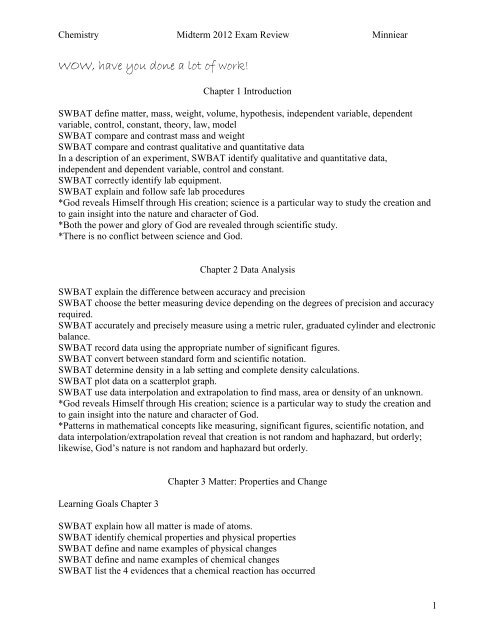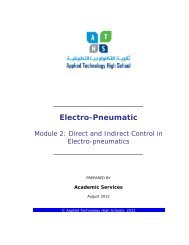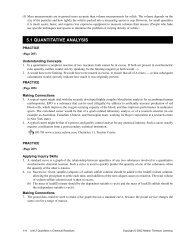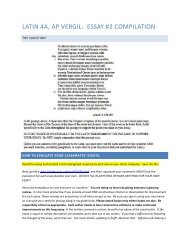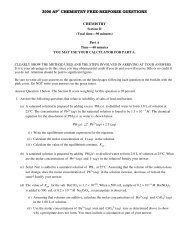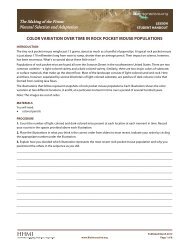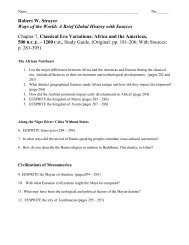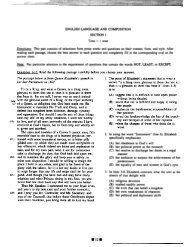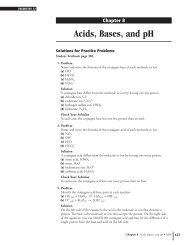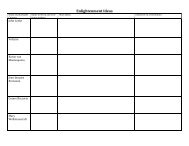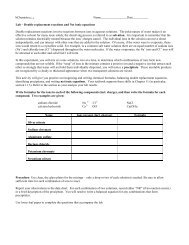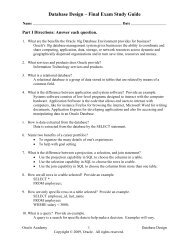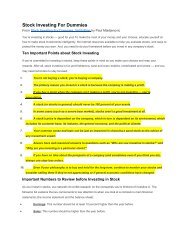Chapter 1 Introduction - Quia
Chapter 1 Introduction - Quia
Chapter 1 Introduction - Quia
Create successful ePaper yourself
Turn your PDF publications into a flip-book with our unique Google optimized e-Paper software.
Chemistry Midterm 2012 Exam Review Minniear<br />
WOW, have you done a lot of work!<br />
<strong>Chapter</strong> 1 <strong>Introduction</strong><br />
SWBAT define matter, mass, weight, volume, hypothesis, independent variable, dependent<br />
variable, control, constant, theory, law, model<br />
SWBAT compare and contrast mass and weight<br />
SWBAT compare and contrast qualitative and quantitative data<br />
In a description of an experiment, SWBAT identify qualitative and quantitative data,<br />
independent and dependent variable, control and constant.<br />
SWBAT correctly identify lab equipment.<br />
SWBAT explain and follow safe lab procedures<br />
*God reveals Himself through His creation; science is a particular way to study the creation and<br />
to gain insight into the nature and character of God.<br />
*Both the power and glory of God are revealed through scientific study.<br />
*There is no conflict between science and God.<br />
<strong>Chapter</strong> 2 Data Analysis<br />
SWBAT explain the difference between accuracy and precision<br />
SWBAT choose the better measuring device depending on the degrees of precision and accuracy<br />
required.<br />
SWBAT accurately and precisely measure using a metric ruler, graduated cylinder and electronic<br />
balance.<br />
SWBAT record data using the appropriate number of significant figures.<br />
SWBAT convert between standard form and scientific notation.<br />
SWBAT determine density in a lab setting and complete density calculations.<br />
SWBAT plot data on a scatterplot graph.<br />
SWBAT use data interpolation and extrapolation to find mass, area or density of an unknown.<br />
*God reveals Himself through His creation; science is a particular way to study the creation and<br />
to gain insight into the nature and character of God.<br />
*Patterns in mathematical concepts like measuring, significant figures, scientific notation, and<br />
data interpolation/extrapolation reveal that creation is not random and haphazard, but orderly;<br />
likewise, God’s nature is not random and haphazard but orderly.<br />
Learning Goals <strong>Chapter</strong> 3<br />
<strong>Chapter</strong> 3 Matter: Properties and Change<br />
SWBAT explain how all matter is made of atoms.<br />
SWBAT identify chemical properties and physical properties<br />
SWBAT define and name examples of physical changes<br />
SWBAT define and name examples of chemical changes<br />
SWBAT list the 4 evidences that a chemical reaction has occurred<br />
1
Chemistry Midterm 2012 Exam Review Minniear<br />
SWBAT explain the differences between pure substances (elements and compounds) and<br />
mixtures (heterogeneous and homogeneous)<br />
SWBAT classify material as pure substances (elements and compounds) or mixtures<br />
(heterogeneous and homogeneous)<br />
SWBAT describe different techniques used to separate mixtures.<br />
SWBAT apply the Law of Conservation of Mass to chemical reactions.<br />
SWBAT explain what the Law of Definite Proportions means.<br />
SWBAT complete percent by mass calculations<br />
*The Law of Conservation of Mass (and Energy) means that the amount of mass and energy in<br />
the universe is constant; it has not changed since the creation. Every atom that exists today has<br />
existed since it was created. Only God can create something out of nothing; all we can do is<br />
rearrange it.<br />
*There are 92 known naturally occurring elements, but almost all known matter is mostly<br />
composed of about 20 common elements; this illustrates the creative nature of the Creator.<br />
*Our ability to rearrange atoms in order to form previously unknown chemical compounds<br />
(materials and medicines, for example) reflects the creativity of the Creator as we are made in<br />
His image.<br />
<strong>Chapter</strong> 4 Structure of the Atom<br />
SWBAT identify the major contributors to modern atomic theory and their major contributions:<br />
Dalton, Thomson, Millikan, Rutherford, Chadwick<br />
SWBAT compare and contrast the “plum pudding” and nuclear (or Rutherford) atomic models.<br />
SWBAT describe Rutherford’s gold foil experiment<br />
SWBAT define atom<br />
SWBAT describe the major parts and general structure of an atom including location and charges<br />
of the subatomic particles<br />
SWBAT define and locate on the periodic table: atomic number, atomic mass<br />
SWBAT explain the role of the atomic number in the identification of an atom.<br />
SWBAT explain that elements are arranged on the periodic table by increasing atomic mass<br />
SWBAT to define isotope<br />
SWBAT determine an isotope’s mass number<br />
SWBAT determine which is the most abundant isotope based on the atomic mass<br />
SWBAT write and interpret isotopic notation<br />
Given its symbol, SWBAT determine the number of subatomic particles in an isotope<br />
SWBAT explain the relationship between an unstable nucleus and radioactive decay<br />
SWBAT characterize alpha, beta and gamma radiation in terms of mass and charge.<br />
Given the percent abundances, SWBAT calculate the atomic mass for an element.<br />
*Structure requires a designer; atomic structure clearly reflects a careful, orderly, extraordinary<br />
design. It is not random or chaotic, but orderly and impossible in its detail, size, and sheer<br />
numbers.<br />
*The numerical sequence of increasing atomic number reflects a God that “thinks” rationally and<br />
mathematically.<br />
2
Chemistry Midterm 2012 Exam Review Minniear<br />
<strong>Chapter</strong> 5 Electrons in Atoms<br />
SWBAT compare and contrast the dual nature of light (wave model and particle model)<br />
SWBAT explain the main points in the continuing development of the atomic model (post<br />
Rutherford)<br />
SWBAT describe how the development of the atomic model was a collaborative effort and<br />
identify the major contributors (Planck, Bohr, De Broglie, Heisenberg, Schrödinger)<br />
SWBAT explain why each element has a unique emission spectrum<br />
Ground state and excited state<br />
Quanta, photons<br />
SWBAT explain the main points of the Bohr Model and the Quantum Model<br />
SWBAT predict electron configuration by completing spdf notation, orbital notation, and<br />
electron dot symbols for elements<br />
Aufbau principle<br />
Pauli exclusion principle<br />
Hund’s rule<br />
Sublevels and orbitals<br />
*In studying the atom, particularly the subatomic particles, we begin to find apparent<br />
contradictions and impossibilities…yet matter clearly exists and functions in predictable ways.<br />
This begins to demonstrate how limited we are in our understanding of God’s thoughts and<br />
God’s ways.<br />
* The incredible complexity and order at the subatomic level clearly evidences an intelligently<br />
designed creation by a Creator of unfathomable intelligence and creativity.<br />
<strong>Chapter</strong> 6 The Periodic Table and Periodic Law<br />
SWBAT identify key features of the periodic table<br />
SWBAT identify the contributions of the developers of the modern periodic table – Mendeleev<br />
and Moseley<br />
SWBAT define ionization energy, electron affinity, and electronegativity.<br />
SWBAT explain the role of ionization energy and electron affinity in the formation of ions<br />
SWBAT identify and explain trends in atomic radius by period and group, trends in ion radius,<br />
trends in ionization energy by period and group, trends in electronegativity by period and group.<br />
*It is important to note that Mendeleev did not impose order on the elements; he discovered the<br />
key to the orderliness that is part of their created nature. This orderliness reflects the Creator.<br />
Creation is not random, chaotic, or haphazard; like its Creator, it is beautiful and complex with<br />
levels of structure and order that we are only beginning to penetrate.<br />
<strong>Chapter</strong> 7 and 8 Bonding and Nomenclature<br />
SWBAT explain why atoms bond (lower energy state is more stable)<br />
SWBAT explain and apply the Octet Rule<br />
SWBAT define Ionic Bonds, Covalent Bonds and Metallic Bonds<br />
SWABT compare and contrast between the different types of bonds<br />
3
Chemistry Midterm 2012 Exam Review Minniear<br />
SWBAT predict ionic bond formation<br />
SWBAT determine the charges on ions using the periodic table for Main Group elements<br />
SWBAT define ion, cation, anion, formula unit, molecule<br />
SWBAT determine the ratios of atoms in an ionic compound based on their charges<br />
SWBAT predict the formula unit for binary ionic compounds<br />
SWBAT name binary ionic compounds<br />
SWBAT recall the names, formulas and charges for the most common polyatomic ions: NH 4 ,<br />
NO 2 , NO 3 , OH, C 2 H 3 O 2 , CO 3 , HCO 3 , SO 4 , SO 3 , PO 4 , ClO, ClO 2 , ClO 3 , ClO 4<br />
SWBAT determine the oxidation number of metals with multiple oxidation numbers in a binary<br />
compound<br />
SWBAT name binary and ternary acids<br />
SWBAT predict covalent bond formation<br />
SWBAT complete Lewis formulas and line formulas for simple covalent compounds.<br />
SWBAT name covalent compounds<br />
SWBAT determine the molecular formula for covalent compounds<br />
SWBAT define polarity<br />
SWBAT define and apply VSEPR<br />
SWBAT to predict simple molecular shapes<br />
SWBAT predict which molecules will be polar molecules<br />
SWBAT explain the Free-Electron Theory<br />
SWBAT explain how the physical properties of metals relate to metallic bonding<br />
4


